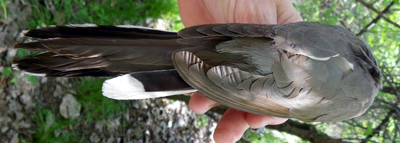The most intense fall landbird migration generally occurs during the
last third of September and the first half of October along the Lake Erie
coastline. Fall 2013 was shaping up to be one of the best on record as we
passed through September. The Navarre Banding Station is located on
private property but there is a management agreement with the U.S. Fish and Wildlife
Service resulting in closure when the government shutdown on October 1st.
With that went our field work. Sixteen days, of what appeared to be very good
bird movement was lost.
On October 17th the study site could again
be opened. Important data lost was the transition from the September
speciation and the mid-October community. Warbler diversity reduced and the
Blackpoll changed over to the Myrtle; Swainson’s and Gray-cheeked gave way to Hermit
Thrush; Kinglets, Winter Wren, and creepers arrived to replace vireos and the warbler diversity as sub-dominants. When was the change over? What was the
volume and how does 2013 compare to normality? In terms of the data, it was a
major hit to a long-term study.
 |
| Hermit Thrush (HETH) left with reddish wings and less apparent eye ring than the Swainson's Thrush (SWTH) right with buffy obvious eye ring. |
 |
HETH Left with brown back and reddish tail and SWTH right with brown back and tail
|
It is consistency that is the greatest value
for migration interpretation.
Can the
loss of days and data be overcome? Those are big questions. We are hoping weather allows for a
ten day to two week block of field work to have strong pre and post closure
data sets to look at. We will be looking at our satellite stations and maybe
turn the table and have them represent the control to assess bird movement this
October. Big questions, the long-term data has never
been more important and now we have new variables. Stay tuned as we work
through these new complications.
Highlights for October 17-20th were seven species of warbler including Black-throated Blue, Myrtle, American Redstart, Tennessee, Nashville, and Blackpoll.
 |
| Male Rusty Blackbird with its "rusty" basic plumage which feathers will wear off "rust" color by spring to leave a nice iridescent black feathered head. |
The first appearance of Fox Sparrows arrived at the Navarre Station along with a couple Red-breasted Nuthatches being observed. Look forward to the cold fronts to likely bring the American Tree Sparrow from its northern territory.
 |
| Fox Sparrow (FOSP) - note bi-colored bill and distinct spots on breast |
 |
| Back of FOSP showing the diagnostic "red" tail of Fox Sparrows |




















































